Ultrabook Head to Head: Acer Aspire S3 vs. ASUS UX31E
by Jarred Walton & Manveer Wasson on December 21, 2011 5:40 AM ESTNetbook Levels of Battery Life
When netbooks came on the scene, they made the idea of a $1000+ ultraportable seem rather laughable. Several years later we’re rebranding ultraportables as ultrabooks (provided they have Intel Inside) and giving it another go. Of course, ultrabooks pack a few tricks like SSDs for better battery life and performance, and Intel’s ULV Sandy Bridge processors are proving to be very efficient when it comes to saving power. We ran our usual suite of battery life tests, with the LCDs set to as close to 100 nits as possible (50% brightness on the Acer S3 and 18% brightness on the ASUS UX31E).
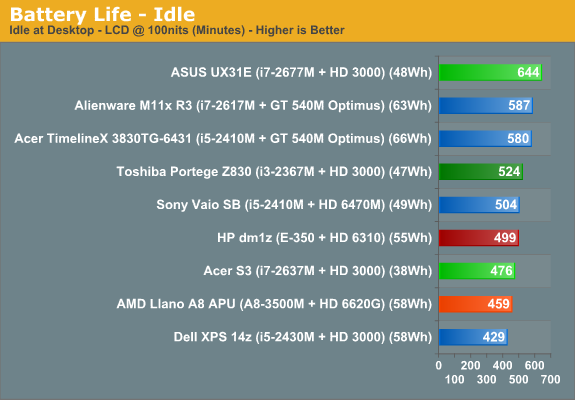
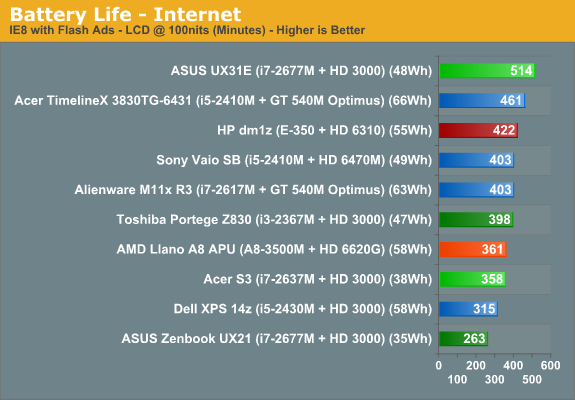
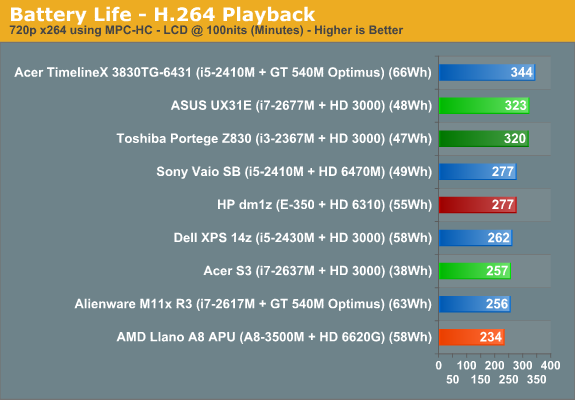
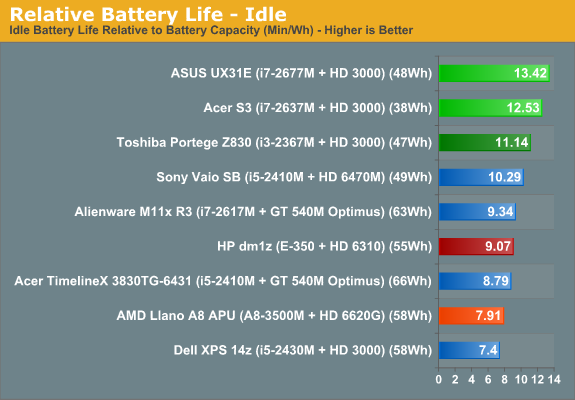
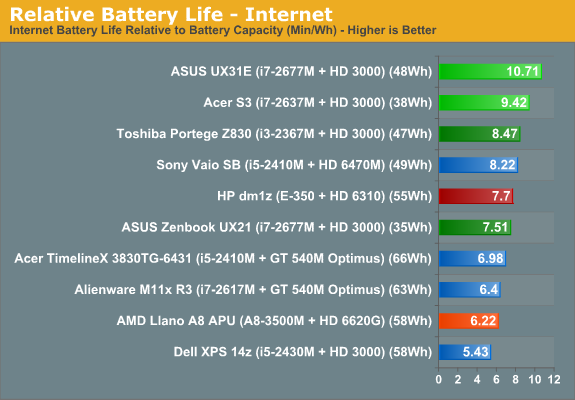

The Acer has a much smaller 3-cell battery, but even with a 38Wh capacity it still boasts respectable battery life of over four hours of H.264 playback and nearly eight hours of idle time. Switch over to the UX31E and not only do you get a higher battery capacity, you also get apparently better power optimizations. In our H.264 test the ASUS “only” manages close to 5.5 hours of playback, while it jumps to 8.5 hours of Internet surfing and over 10.5 hours of idle time. Look at the relative battery life charts and the results are even more impressive: the three ultrabooks we’ve reviewed place at the top of the charts, and even if we compare with Atom, the UX31E matches and sometimes exceeds what the best netbooks could achieve; the other two ultrabooks where we’ve done full reviews also place near the top of our relative battery life charts.
Something else we tested that we don’t have in the above charts is idle battery life with the LCD at maximum brightness. The Acer drops to 400 minutes, but then it only gets about 120% brighter as we’ll see on the next page. The UX31E on the other hand does a swan dive down to just 357 minutes, but you have to take into consideration the 450% increase in brightness. Put another way, power draw for the Acer is around 4.7W at 107 nits (50%) and 5.59W at 234 nits (100%); the ASUS on the other hand uses 4.38W at 93 nits (18%) and jumps up to 7.91W at 519 nits (100%). Even though that’s a pretty big jump in power use, we still have to credit the LED backlighting technology: 500+ nits for less than 5W of power isn’t really that bad.
The short summary here is that you may have to pay more, but you do get substantially better performance than a netbook, you don’t sacrifice much in the size or battery life departments, and build quality is generally far higher than inexpensive laptops and netbooks. Does that make ultrabooks a better option than other laptops? Not for everyone, but there are certainly people that will like what ultrabooks have to offer.










81 Comments
View All Comments
AssBall - Wednesday, December 21, 2011 - link
You know what would be cool? A 17" ultrabook. You could get a nice big screen and a keyboard that is not all clusterjammed in there. I hate tiny laptop keyboards.Nice review Jarred. I don't think I will be picking up one of these ultra's anytime soon. Looking forward to the Samsung review though.
Malih - Wednesday, December 21, 2011 - link
yes, I've been wondering why most thin laptops are limited to 13.3", would the extra space not be useful, or is it the limitation set by Intel, or is it because Apple don't make 15" MBA or is a 15" aluminum case cost too much to produce?17" might not be for everyone, but 14" or 15" are preferable for the masses, and with 15" you don't have to compete directly with Apple.
AssBall - Wednesday, December 21, 2011 - link
Maybe it is too expensive... I don't know. Plus the battery would be larger I suppose. It starts to get heavy and is no longer "ultra".I'd be very interested in a Llano based 17" Ultrabook with say a 128GB SSD, a more spread out keyboard, and a matte screen. Make the touch pad not suck too, please.
Thanks Santa.
cobalt42 - Wednesday, December 21, 2011 - link
Agree with both. If they used the extra keyboard space to make a nice cursor key cluster (arrow keys as well as home/end/pgup/pgdown and ins/del), they'd get my money. The others at that size either put a numeric keypad, or worse, nothing and just waste the extra space.AssBall - Wednesday, December 21, 2011 - link
Arrow keys and the home section, sometimes I wish they would toss it out because all of that stuff is on the number pad anyway. At least it is with my 12 year old WYSE keyboard. And then they could keep some space away from the standard qwerty section. I'd like that style of board. I don't much care for small function keys all crowded down either.Guspaz - Wednesday, December 21, 2011 - link
Strength becomes a bigger issue. If you keep the thickness the same, but increase the size to 17", the laptop would be enormously more delicate. More stress would be placed on it, if only because of the whole law-of-the-lever type thing. They'd have to make the 17" ultrabooks correspondingly thicker and more durable, and that would negate at least some of the advantage.A 15" ultrabook could be a lot more interesting, especially if they take advantage of a thinner bezel to fit the larger screen into a chassis that was only slightly larger than existing 13.3" ultrabooks.
Iketh - Wednesday, December 21, 2011 - link
nah I don't think durability would be hard to figure out, tho achieving that durability would likely increase the cost a good bitwadcock2 - Saturday, April 7, 2012 - link
ultrabook is define by Intel as a subnotebook with smaller size and weight. They are usually less than 6.5 lbs. They often have 7 -10 battery life (yea!). and are thin (< .7") to compete with Mac AirPro. There was one web page were the notebook had to fit into an 8.5"x11 interoffice mailing envelope. That also would require a smaller screen.I find that the 1366x768 pixel screens are too small to hole a whole video, photo or chart of today's web pages.
Yes, I'd like a light weight 17" laptop with long battery life and high screen resolution. The nearly 10 lbs plus another 2-4 for the power adapter makes it heavy to carry around and heavy on my lap.
bji - Wednesday, December 21, 2011 - link
Apple is supposed to be coming out with a 15 inch macbook air late Q1 next year. I am waiting for this and it will buy one; it will replace my 7 year old Panasonic Toughbook Y2 that thus far has not had a competitor for light weight, screen size, and build quality in the 14 inch+ size range.niva - Wednesday, December 21, 2011 - link
Right on, 17" frame will probably allow them to squeeze in a decent GPU in there too, something better than the integrated intel HD chip. Possibly even room for a hard drive to add more storage overall.The big thing I'm taking away from this review is the terrible screens. I'm surprised that they are that bad compared to the Apple screens. As much as many of us hate Apple and bash on them in the comments they've always been good about their displays.
Dell and Samsung are the companies who can buck this trend with terrible displays in these devices, lets hope it happens soon.